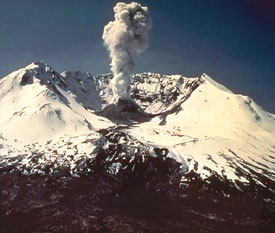
LAB 4
Volcanic Hazards
Lava dome in the crater of Mt. St. Helens, 1982
|
|
LAB 4 Volcanic Hazards |
|
Lava dome in the crater of Mt. St. Helens, 1982 |
Objectives:
The focus of this lab is how volcanic processes change the face of the earth and how these changes may adversely affect society. From news coverage of recent volcanic eruptions, we see that volcanoes have the potential to be destructive events that damage property and threaten people’s lives. In this lab we first learn about the characteristics of volcanic events that pose hazards. We then study a recent volcanic eruption at Mt. St. Helens and put this famous 1980 eruption into perspective with a comparison to eruptions of other volcanoes around the world. Last, we will evaluate the potential volcanic hazards that threaten large metropolitan areas in the United States and globally.Reading:
Skinner, Porter & Botkin, The Blue Planet Chap. 7: p.135-146.Useful web sites:
Volcano World
volcano.und.nodak.edu/US Geological Survey Volcanology links
www.usgs.gov/network/science/earth/volcano.htmlCascades Volcano Observatory
vulcan.wr.usgs.govHawaii Volcano Observatory
hvo.wr.usgs.gov/
Potential Volcanic Hazards:
On the human time scale, volcanic eruptions occur infrequently and cause low annual damage compared to other hazards, such as earthquakes, floods, and ground failures (subsidence, sinkholes, landslides). Nevertheless, for those who live in volcanic regions, the severity of the hazards caused by potential eruptions makes them an important consideration in land use decisions. In the first part of the lab we will consider the most common of these hazards, reviewed below:Lava Flows. The rate of lava release, the slope of the surface onto which it is erupted, and the viscosity of the lava determine the nature of lava flows. Rates of movement vary considerably, from a few to hundreds of meters per hour for silicic lava flows, to several kilometers per hour for basaltic lava flows. Because of their slow rates of movement, lava flows seldom threaten human life. The major hazard from lava flows is from burying, crushing, or burning objects in their paths. Fires started by lava flows can affect areas far beyond their edges.
Pyroclastic Flows. Among the most hazardous of volcanic events are pyroclastic flows. These events, associated with explosive eruptions, are gravity-driven, rapidly moving, ground hugging mixtures of extremely hot rock fragments and gases. Although pyroclastic flows contain mostly solid material, they flow downslope like a fluid. They owe their mobility to hot air and volcanic gases that provide a cushion for the solid particles. Like large avalanches, these flows can affect areas many kilometers from a volcano.
Structural Collapse. Rock avalanches on volcanoes range from relatively small events to some of the most voluminous mass movements known. They may exist as small landslides on a crater wall or during the failure of a giant portion of a volcano’s mountainside. Large debris avalanches bury and destroy everything in their paths and greatly alter pre-existing topography.
Mudflows. Water mixed with volcanic materials can produce mudflows, also known as lahars, during eruptions. Lahars threaten lives and property both on volcanoes and in the valleys that drain them. Because of their high velocity and bulk density, lahars can destroy substantial structures in their paths, such as bridges. Lahar deposits can deeply bury crops and communities, even at considerable distances from an eruption.
Tephra. Tephra consists of fragments of molten or solid rock that are ejected into the atmosphere from an explosive volcanic eruption; layered tephra that accumulates around the eruption site is termed pyroclastic sediment. Tephra ranges in size from ash (<2 mm), to lapilli (2-64 mm), to blocks and bombs (>64 mm) that may reach several meters in diameter. Tephra fall poses the widest-ranging direct hazard from volcanic eruptions.
Mt. St. Helens:
In the second part of the lab, we will examine the effects of the May 18, 1980 eruption of Mt. St. Helens in Washington. This particular volcanic eruption was chosen because:• all aspects of the eruption are well-studied and documented
• it occurred close to heavily populated regions
• it provides a model for potential hazards in tectonically similar regions.
Mt. St. Helens is located in the Cascade Range, which extends from northern California into southern British Columbia. Most active volcanoes in the continental U.S. occur in the Cascades, but Mt. St. Helens is small compared to other Cascade volcanoes. The diagram below shows a reconstruction of events that took place during the May 18, 1980 eruption:
